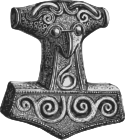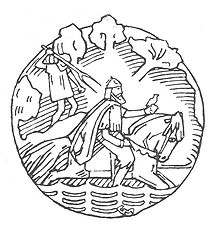- Dag the Wise
-
Dag the Wise or Dagr Spaka (2nd or 3rd century AD) was a mythological Swedish king of the House of Ynglings. He was the son of Dyggvi, the former king. According to legend, he could understand the speech of birds and had a sparrow that gathered news for him from many lands. When the bird was killed on one of these trips, Dag invaded Reidgotaland (considering the date and location, apparently Gothiscandza), in order to avenge it. There he was ambushed by a thrall and killed.
The earliest two versions based on Ynglingatal, i.e. Historia Norwegiæ and Íslendingabók (see below) say that Dag was succeeded by his sons Alrekr and Eírikr who in their turn were succeeded by Dag's grandson Agne (in Historia Norwegiæ incorrectly called Hogne[1]):
Cui [Dyggui] successit in regnum filius ejus Dagr, quem Dani in quodam vado, quod Sciotanvath vel Wapnavath dicitur, dum passeris injurias vindicare conaretur, publico bello occiderunt. Qui genuit Alrik; hunc frater suus Erikr freno percussit ad mortem. Alricr autem genuit Hogna[2]
His [Dyggve's] son Dag succeeded to his throne; he was killed by the Danes in a royal battle at a ford named Skjotansvad, while he was trying to avenge the violence done to a sparrow. This man engendered Alrek, who was beaten to death with a bridle by his brother, Eirik. Alrek was father to Agne, [...][3]
Íslendingabók only lists the line of succession: x Dyggvi. xi Dagr. xii Alrekr. xiii Agni. xiiii Yngvi''.[4]
However, in the Ynglinga saga, Snorri Sturluson gives Agne as Dag's son and successor, and the two brothers Alrekr and Eiríkr as his grandsons.
This is what Snorri tells of Dag:
Dagr hét son Dyggva konungs, er konungdóm tók eptir hann; hann var maðr svá spakr, at hann skildi fugls rödd. Hann átti spörr einn, er honum sagði mörg tíðindi; flaug hann á ymsi lönd. Þat var eitt sinn, at spörrinn flaug á Reiðgotaland, á bœ þann, er á Vörva heitir; hann flaug í akr karls ok fékk þar matar. Karl kom þar ok tók upp stein ok laust spörrinn til bana. Dagr konungr varð illa við, er spörrinn kom eigi heim; gékk hann þá til sónarblóts til fréttar, ok fékk þau svör, at spörr hans var drepinn á Vörva. Síðan bauð hann út her miklum ok fór til Gotlands; en er hann kom á Vörva, gékk hann upp með her sinn ok herjaði: fólkit flýði víðs vegar undan. Dagr konungr sneri herinum til skipa, er kveldaði, ok hafði hann drepit mart fólk ok mart handtekit. En er þeir fóru yfir á nökkura, þar sem heitir Skjótansvað eða Vápnavað, þá rann fram ór skógi einn verkþræll á árbakkann ok skaut heytjúgu í lið þeirra, ok kom í höfuð konungi skotit; féll hann þegar af hestinum ok fékk bana. Í þann tíma var sá höfðingi gramr kallaðr er herjaði, en hermennirnir gramir.[5]
King Dygve's son, called Dag, succeeded to him, and was so wise a man that he understood the language of birds. He had a sparrow which told him much news, and flew to different countries. Once the sparrow flew to Reidgotaland, to a farm called Varva, where he flew into the peasant's corn-field and took his grain. The peasant came up, took a stone, and killed the sparrow. King Dag was ill-pleased that the sparrow did not come home; and as he, in a sacrifice of expiation, inquired after the sparrow, he got the answer that it was killed at Varva. Thereupon he ordered a great army, and went to Gotland; and when he came to Varva he landed with his men and plundered, and the people fled away before him. King Dag returned in the evening to his ships, after having killed many people and taken many prisoners. As they were going across a river at a place called Skjotan's [the Weapon's] Ford, a labouring thrall came running to the river-side, and threw a hay- fork into their troop. It struck the king on the head, so that he fell instantly from his horse and died. In those times the chief who ravaged a country was called Gram, and the men-at-arms under him Gramer.[6][7]
Then Snorri quoted Ynglingatal (9th century):
- Frák at Dagr
- dauða orði
- frægðar fúss
- of fara skyldi,
- þá er valteins
- til Vörva kom
- spakfrömuðr
- spörs at hefna.
- What news is this that the king's men,
- Flying eastward through the glen,
- Report? That Dag the Brave, whose name
- Is sounded far and wide by Fame --
- That Dag, who knew so well to wield
- The battle-axe in bloody field,
- Where brave men meet, no more will head
- The brave – that mighty Dag is dead!
The fact that Skjótansvað/Vápnavað appear both in Ynglinga saga and in Historia Norwegiæ's earlier summary of Ynglingatal but not in Snorri's later quotation from it, suggests that all of Ynglingatal was not presented by him.
Sources
- Ynglingatal
- Ynglinga saga (part of the Heimskringla)
- Historia Norwegiae
Notes
- ^ Storm, Gustav (editor) (1880). Monumenta historica Norwegiæ: Latinske kildeskrifter til Norges historie i middelalderen, Monumenta Historica Norwegiae (Kristiania: Brøgger), p. 99
- ^ Storm, Gustav (editor) (1880). Monumenta historica Norwegiæ: Latinske kildeskrifter til Norges historie i middelalderen, Monumenta Historica Norwegiae (Kristiania: Brøgger), pp. 98-99
- ^ Ekrem, Inger (editor), Lars Boje Mortensen (editor) and Peter Fisher (translator) (2003). Historia Norwegie. Museum Tusculanum Press. ISBN 8772898135, pp. 75-77.
- ^ Guðni Jónsson's edition of Íslendingabók
- ^ a b Ynglinga saga at Norrøne Tekster og Kvad
- ^ a b "Laing's translation at the Internet Sacred Text Archive". Sacred-texts.com. http://www.sacred-texts.com/neu/heim/02ynglga.htm. Retrieved 2010-01-23.
- ^ Samuel Laing (2011-07-16). "Laing's translation". Googlebooks.com. Archived from the original on April 17, 2008. http://web.archive.org/web/20080417210851/http://books.google.com/books?id=AHjOAAAAMAAJ&pg=PA269&dq=%22OE,+THE+STORY+OF+THE+YNGLING+FAMILY+FROM+ODIN+TO+HALFDAN+THE+BLACK.%22&hl=en&ei=XzUiTrXqO8-ftgfE7eWyAw&sa=X&oi=book_result&ct=result&resnum=1&ved=0CC8Q6AEwAA#v=onepage&q=%22OE%2C%20THE%20STORY%20OF%20THE%20YNGLING%20FAMILY%20FROM%20ODIN%20TO%20HALFDAN%20THE%20BLACK.%22&f=false. Retrieved 2010-01-23.
- ^ A second online presentation of Ynglingatal[dead link]
- ^ Samuel Laing (2011-07-16). "Laing's translation". Googlebooks.com. Archived from the original on February 26, 2008. http://web.archive.org/web/20080226053546/http://books.google.com/books?id=AHjOAAAAMAAJ&pg=PA269&dq=%22OE,+THE+STORY+OF+THE+YNGLING+FAMILY+FROM+ODIN+TO+HALFDAN+THE+BLACK.%22&hl=en&ei=XzUiTrXqO8-ftgfE7eWyAw&sa=X&oi=book_result&ct=result&resnum=1&ved=0CC8Q6AEwAA#v=onepage&q=%22OE%2C%20THE%20STORY%20OF%20THE%20YNGLING%20FAMILY%20FROM%20ODIN%20TO%20HALFDAN%20THE%20BLACK.%22&f=false. Retrieved 2011-07-16.
Dag the WisePreceded by
DyggveMythological king of Sweden Succeeded by
AgneNorse paganism Deities,
heroes,
and figuresOthersAsk and Embla · Dís (Norns · Valkyries) · Dwarf · Einherjar · Elves (Light elves · Dark elves) · Fenrir · Hel · Jörmungandr · Jötunn · Sigurd · Völundr · Vættir
Locations Asgard · Bifröst · Fólkvangr · Ginnungagap · Hel · Jötunheimr · Midgard · Múspellsheimr · Niflheim · Valhalla · Vígríðr · Wells (Mímisbrunnr · Hvergelmir · Urðarbrunnr) · YggdrasilEvents Sources Society See also Categories:- 2nd-century births
- 3rd-century deaths
- Mythological kings of Sweden
Wikimedia Foundation. 2010.

